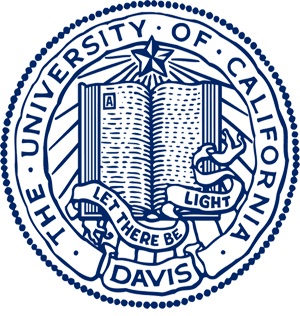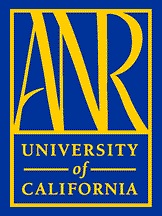Water Savings in Agriculture
Potential Water Savings in Pajaro Valley
by Samuel Sandoval Solis and Vicki Lin
Abstract Full Report Conclusions
Background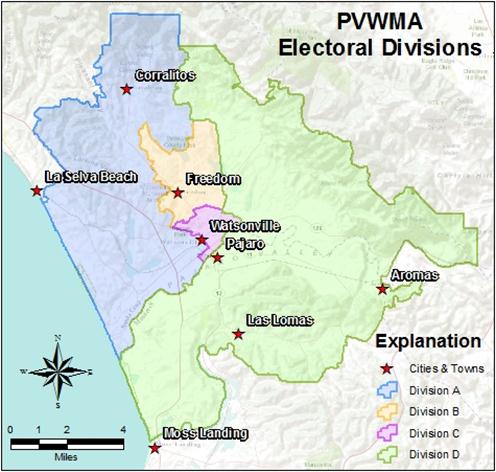
As people of the 21st century, we have been told to use less water due to a water shortage. This suggestion is often taken lightly because even with the warnings, the tap never stops running. Pajaro Valley, an agricultural region in Monterey County (90 miles south of San Francisco), is currently being proactive about these warnings and seeking ways to improve their water conservation. Water conservation not only provides short-term benefits for the environment, but more importantly, it constitutes a long-term investment for the future. Water conservation involves restricting water use and changing water demands, which affects a person’s normal behavior. The prohibition of watering lawns or washing cars during a drought is an example of such.
Roughly 90% of the water delivered by Pajaro Valley’s Water Management Agency (PVWMA) is groundwater. The PVWMA is currently overdrafting their groundwater aquifers, resulting in immediate action in order to protect their water source. The left figure below shows the original state of Pajaro Valley aquifers. Historically, the amount of groundwater in the aquifer was above sea level so the amount of salt water in the freshwater aquifer was kept at bay.
Removing too much water from the ground at a faster rate than it is being replenished has caused seawater from the Pacific Ocean to enter the aquifer as the water level tries to even out. This seawater intrusion impairs water quality as saltwater is too saline for both agriculture and human consumption. PVWMA is currently taking action by implementing seven different projects to control this. One of these projects is their agricultural conservation program.
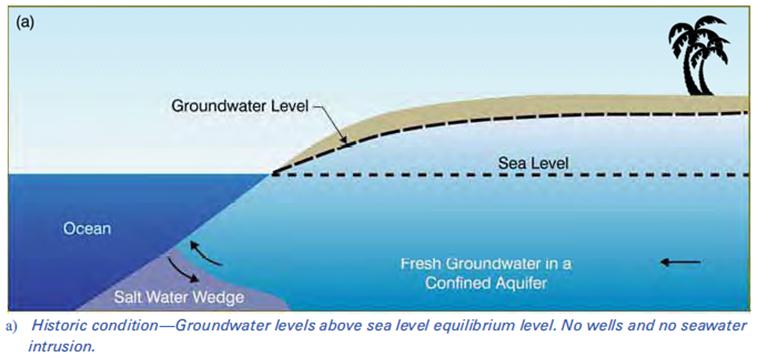 |
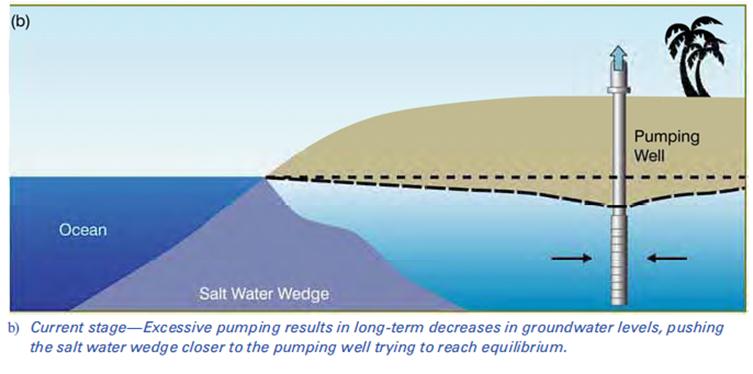 |
| Source: Basin Management Plan of Pajaro Valley (Carollo 2012) | Source: Basin Management plan of Pajaro Valley (Carollo 2012) |
Project Description and Results
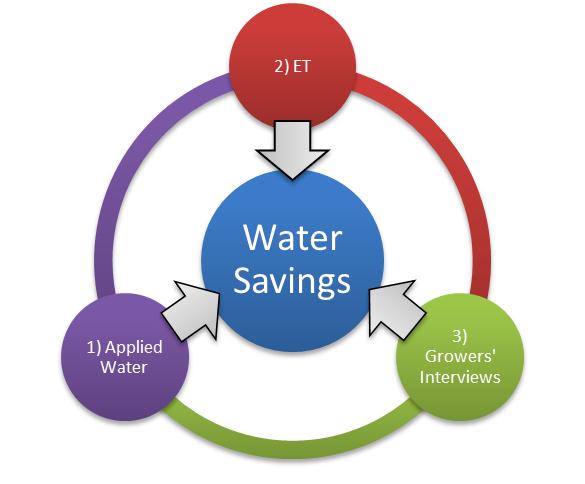 Dr. Sandoval from UC Davis was approached by PVWMA to aid them in their agricultural conservation program. PVWMA wanted to know the volume water that could be potentially saved and the resulting economic impact of water savings on the valley. The key to agricultural water savings is to water a crop to its evapotranspiration (ET) value. The ET value indicates optimum water amounts that should be applied in order for the water to be completely beneficial. Applying any more water than the ET value is considered inefficient because the excess water is not taken up by the crops. In order to estimate the potential water savings, the UC Davis team (Dr Sandoval, Vicki Lin, Jenna Rodriguez and Belize Lane) had to determine how many growers were surpassing a crop’s ET value. This was done by conducting grower interviews, giving us information on the volume of water each grower applied to their crop and the amount of money they invested in crop production. A statistical analysis was then completed with applied water data of growers from PVWMA, information from the growers’ interviews, and expert provided ET values to check for accuracy.
Dr. Sandoval from UC Davis was approached by PVWMA to aid them in their agricultural conservation program. PVWMA wanted to know the volume water that could be potentially saved and the resulting economic impact of water savings on the valley. The key to agricultural water savings is to water a crop to its evapotranspiration (ET) value. The ET value indicates optimum water amounts that should be applied in order for the water to be completely beneficial. Applying any more water than the ET value is considered inefficient because the excess water is not taken up by the crops. In order to estimate the potential water savings, the UC Davis team (Dr Sandoval, Vicki Lin, Jenna Rodriguez and Belize Lane) had to determine how many growers were surpassing a crop’s ET value. This was done by conducting grower interviews, giving us information on the volume of water each grower applied to their crop and the amount of money they invested in crop production. A statistical analysis was then completed with applied water data of growers from PVWMA, information from the growers’ interviews, and expert provided ET values to check for accuracy.
Land use data sets from 2009 and 2011 were analyzed in this project. The analysis focused on 2009 because it was a normal year in terms of precipitation and climate conditions in the valley. In summary, Pajaro Valley can save between 4,600 and 5,100 AF/year through conservation. A range is provided because during the land use survey done by PVWMA, there was some agricultural land that did not have a crop assigned; these areas were labeled as Unknown Agriculture. PVWMA was unsure of 16% of the crops grown in the valley; in essence, they could not specify the type of crop that was grown in these areas, they only knew they were productive regions. There is an estimated total water savings of 4,600 AF/year if any potential water savings in the “unknown agriculture” area are disregarded. If this area is considered and the unknown agriculture land is assumed to follow the same distribution of crops as the rest of the valley, then the total potential water savings are estimated as 5,100 AF/year. This agricultural water savings program is anticipated to contribute to 41% of the regions total water savings just by using water more efficiently.
Economic Impact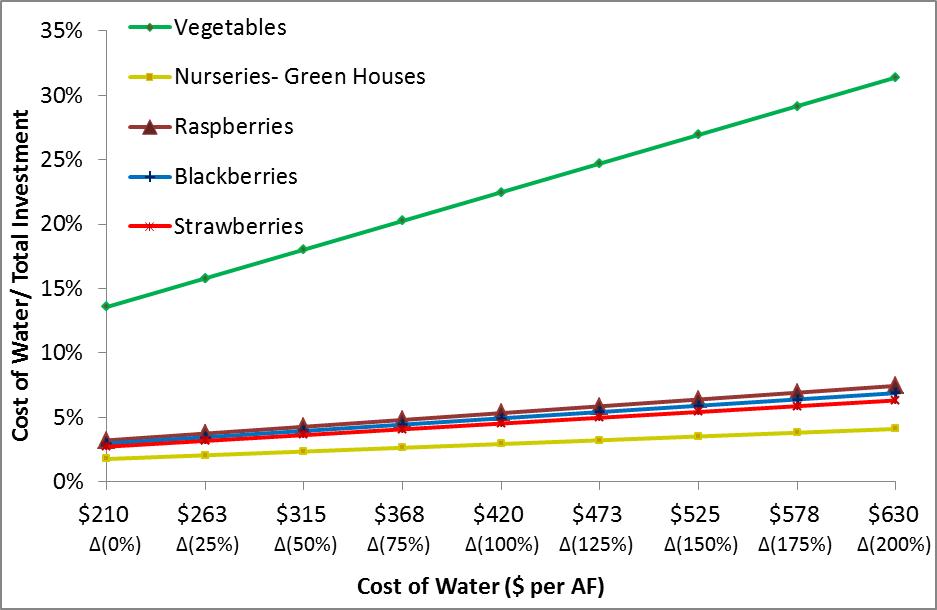
This increase in water savings results in a direct decrease in revenue for PVWMA ranging from $862,000 to $951,000. To compensate for this loss in revenue, a potential increase in water extraction fee rates was analyzed. In summary, this increase will affect farmers, especially vegetable crop growers in the coastal region of Pajaro Valley because they already put 60% of their total net profits into their investment cost. These coastal vegetable growers currently receive estimated revenue of $3,910 per growing season.If their water rates are increased by 50% ($105/AF), their revenue will be decreased 6.9% ($271) per growing season. The graph shows how an increase in rates will affect farmers, substantially lowering their net profit on crops. Growers of strawberries, raspberries, blackberries, and nurseries have a larger return on their investments, so an increase in water fees will not affect them as dramatically.
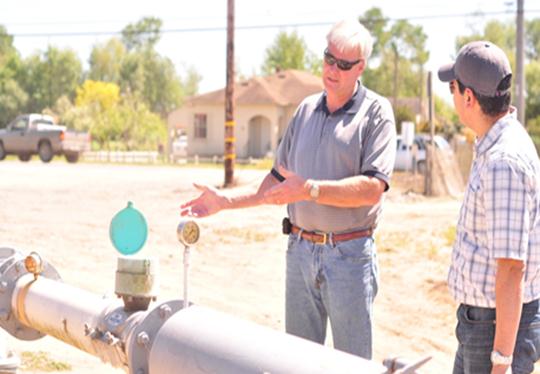 |
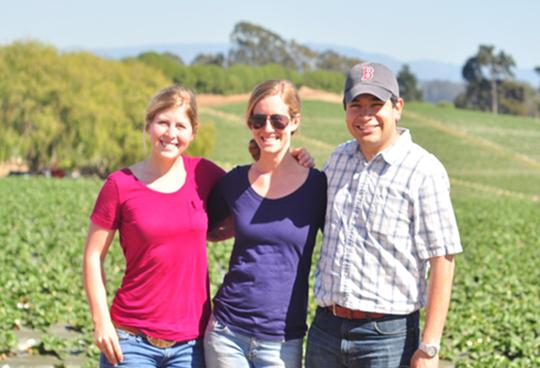 |
| Dr. Sandoval conducting a grower’s interview with John Eiskamp | From left to right: Jenna M., Belize L., Dr. Sandoval (Absent: Vicki Lin) |
Landscapes of Pajaro Valley
Flower Productions and Nurseries in Pajaro Valley
Strawberry fields
Looking Towards West: Monterey Bay
Looking towards East: San Andreas Fault


